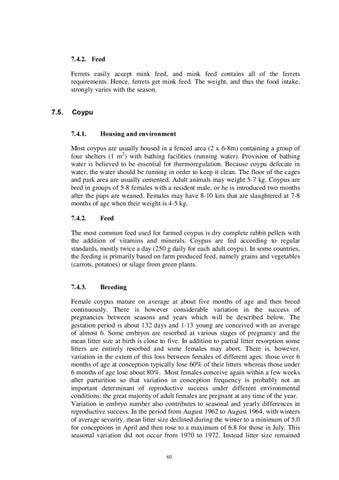)HHG Ferrets easily accept mink feed, and mink feed contains all of the ferrets requirements. Hence, ferrets get mink feed. The weight, and thus the food intake, strongly varies with the season.
&R\SX
+RXVLQJ DQG HQYLURQPHQW
Most coypus are usually housed in a fenced area (2 x 6-8m) containing a group of four shelters (1 m2) with bathing facilities (running water). Provision of bathing water is believed to be essential for thermoregulation. Because coypu defecate in water, the water should be running in order to keep it clean. The floor of the cages and park area are usually cemented. Adult animals may weight 5-7 kg. Coypus are bred in groups of 5-8 females with a resident male, or he is introduced two months after the pups are weaned. Females may have 8-10 kits that are slaughtered at 7-8 months of age when their weight is 4-5 kg.
)HHG
The most common feed used for farmed coypus is dry complete rabbit pellets with the addition of vitamins and minerals. Coypus are fed according to regular standards, mostly twice a day (250 g daily for each adult coypu). In some countries, the feeding is primarily based on farm produced feed, namely grains and vegetables (carrots, potatoes) or silage from green plants.
%UHHGLQJ
Female coypus mature on average at about five months of age and then breed continuously. There is however considerable variation in the success of pregnancies between seasons and years which will be described below. The gestation period is about 132 days and 1-13 young are conceived with an average of almost 6. Some embryos are resorbed at various stages of pregnancy and the mean litter size at birth is close to five. In addition to partial litter resorption some litters are entirely resorbed and some females may abort. There is, however, variation in the extent of this loss between females of different ages: those over 6 months of age at conception typically lose 60% of their litters whereas those under 6 months of age lose about 80%. Most females conceive again within a few weeks after parturition so that variation in conception frequency is probably not an important determinant of reproductive success under different environmental conditions: the great majority of adult females are pregnant at any time of the year. Variation in embryo number also contributes to seasonal and yearly differences in reproductive success. In the period from August 1962 to August 1964, with winters of average severity, mean litter size declined during the winter to a minimum of 5.0 for conceptions in April and then rose to a maximum of 6.8 for those in July. This seasonal variation did not occur from 1970 to 1972. Instead litter size remained 60
